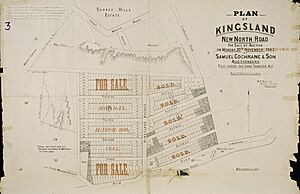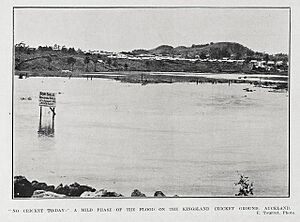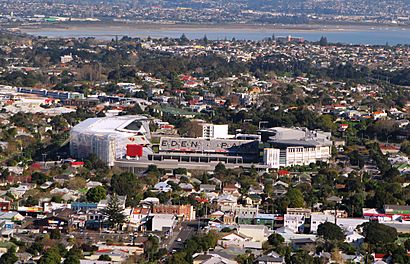Kingsland, New Zealand facts for kids
Quick facts for kids
Kingsland
|
|
|---|---|
|
Suburb
|
|
 |
|
| Country | New Zealand |
| Local authority | Auckland |
| Electoral ward | Albert-Eden-Puketāpapa ward |
| Local board | Albert-Eden Local Board |
| Established | 1880s |
| Area | |
| • Land | 77 ha (190 acre) |
| Population
(June 2023)
|
|
| • Total | 3,410 |
| Train station(s) | Kingsland railway station |
|
|
||
Kingsland is a cool inner-city neighborhood in Auckland, New Zealand. Auckland is the biggest city in New Zealand. Kingsland is looked after by the Auckland Council. It's super famous because it's home to Eden Park, New Zealand's largest stadium. This stadium even hosted the finals of the 2011 Rugby World Cup! Kingsland also has a lively village center. Here you can find shops, restaurants, pubs, and fun monthly markets.
Kingsland started to grow in the 1880s when land was sold. Many of its buildings were built in the early 1900s. New North Road is the main street in Kingsland. It runs from the city center through the suburb. Kingsland's main street is right by the Kingsland railway station. It is also directly across from Eden Park.
Contents
Kingsland's Past: A Brief History
A long time ago, much of Kingsland was swampland. The local Tāmaki Māori people called it Ngā Anawai. This name means "water-filled lava-flow caves." These caves were formed over 30,000 years ago. They were created by ancient volcanoes like Maungawhau / Mount Eden and Mount Albert.
Kingsland's story is connected to how Europeans settled Auckland. In 1835, a trader named Thomas Mitchell bought land from Āpihai Te Kawau. He was a chief of the local Māori tribe, Ngāti Whātua. Later, in 1841, Te Kawau gave 3,000 acres (1,200 ha) to the government. This helped Auckland become a city.
In 1852, John McElwain bought 55 acres (22 ha) for farming. His brother gave him another 60 acres (24 ha) nearby. This land is now part of Kingsland. An old road in the area was called Cabbage Tree Swamp Road. But settlers wanted a new name. So, in 1877, it became Kingsland Road.
The area was quite rough, so it grew slower than other parts of Auckland. In the 1860s, New North Road was built. It gave people better access to the area. It was also an alternative to the Great North Road. In 1866, the first local government was formed. It was called the Mt Albert District Highway Board. It looked after New North Road. A tollbooth was set up in Kingsland from 1875 to 1888.
The Kingsland railway station opened in 1880. This helped the suburb grow a lot. Auckland's population grew quickly in the late 1800s. This put pressure on areas close to the city. With new train and bus links, John McElwain decided to divide his farm into smaller plots. In 1882, 227 plots of land were created. New roads like Kingsland Avenue and First to Fourth Avenues were built. Land prices ranged from £28 to £100. Other housing areas also grew in Kingsland.
Another big growth spurt happened in the early 1900s. The Auckland tramline reached Kingsland in 1903. The community grew around Arthur W. Page's general store. Soon, many new shops opened. More housing areas were developed. By the 1910s, Kingsland became a suburb where many people lived and commuted to work.
A. W. Page and his brother built more onto his store in 1913 and 1914. They also built the Portland Building. A new post office was built in Kingsland in 1912. St George's Anglican Church followed in 1913. A cinema, the Theatre Royal, opened in 1915. Eden Park became a major sports venue in the 1910s and 1920s. It hosted cricket and rugby games.
In the 1970s, Kingsland became home to many Urban Māori and Pasifika families. This was because other inner-city areas became more expensive. The Northwestern Motorway was built through Kingsland in the 1970s. This changed how some streets connected. In 1997, a big recording studio called Kog Transmissions opened. Famous New Zealand musicians recorded there.
Kingsland got a big makeover in the early 2000s and 2010s. Eden Park and the Kingsland railway station were upgraded. This was all for the 2011 Rugby World Cup.
Kingsland's People: Demographics
The Kingsland area is about 0.77 square kilometers. It had an estimated population of 3,162 people in 2023. This means about 4,100 people live in each square kilometer.
In the 2023 census, Kingsland had 3,162 people. This was a small decrease from 2018. The average age was 32.8 years old. About 12% of the people were under 15 years old. About 30% were aged 15 to 29. Over half, 51.8%, were aged 30 to 64. About 5.9% were 65 or older.
People in Kingsland come from many backgrounds. About 77% are European. About 12.8% are Māori. Around 12.4% are Pasifika. About 11.6% are Asian. English is spoken by most people (96.7%). Some also speak Māori (3.2%) or Samoan (2.2%).
Many people in Kingsland have a good education. Over half (50.9%) have a bachelor's degree or higher. The average income was $60,400. Most people (67.3%) work full-time.
Cool Places and Features in Kingsland
Eden Park: New Zealand's Biggest Stadium
Eden Park is New Zealand's largest stadium. It can hold 50,000 people! Every year, almost half a million sports fans visit for games and events.
Before the 2011 Rugby World Cup, the park had a huge upgrade. It cost $240 million and took three years. They added four giant Māori carvings at the main entrances. These carvings represent important Māori gods:
- Tāne-mahuta, the spirit of the forest.
- Rongo, the god of peace.
- Tūmatauenga, the god of war.
- Tāwhirimātea, the god of wind.
These amazing carvings were designed by Ngāti Whātua carver, Arekatera Maihi.
Eden Park started as a sports ground in 1900. By 1914, it was drained and turned into two cricket ovals. It has been the home of Auckland Cricket since 1910. It has also been home to Auckland Rugby since 1925. Over its 100-year history, it has hosted many famous events. These include the 1950 British Empire Games, the first 1987 Rugby World Cup, and the 1992 Cricket World Cup. Today, it regularly hosts big rugby and cricket matches. It was also a co-host for the 2015 Cricket World Cup.
Famous Buildings in Kingsland
Many old buildings in Kingsland have been saved. They are now used for new purposes.
- Shooters Bar (330 New North Road) — This building is from the 1910s-1920s. It was once two separate buildings. It has been a shoe shop, an office, and an event venue. It's next to the old kiwi bacon factory. The building has been updated but still keeps its historical look.
- Trinity Methodist Church & Jubilee Hall (400 New North Road) — The church was built in 1897. The Jubilee Hall was built in 1909. The church has special windows. They remember local men who died in the World Wars.
- Windsor Dairy Buildings (434–442 New North Road) — These were built as two separate buildings around 1900-1910. A new front was added in 1940 to make them look like one.
- Public Amenity Building (448 New North Road) — Built in 1928, these public toilets are a great example of Art Deco style. They were built after some accidents at the station.
- Pages Buildings and Grain Store (460–470 New North Road) — The first Pages Stores were built in the late 1880s. They were close to the train and tram stops. These businesses sold goods and food for local farmers. The Grain Store buildings are from 1900–1914.
- Kingsland Post Office (478 New North Road) — This building is from 1911. It was designed by architect John Campbell. It mixes Edwardian Classical Revival and Arts and Crafts styles. The Post Office was used until 1989.
- Theatre Royal (486 New North Road) — Built in 1915, this theatre showed movies. It was one of many new cinemas in Auckland. It closed as a cinema in 1978. It was updated in 1996 and is now a shop.
- Kingsland Fire Station (516 New North Road) — This fire station was built in 1933. It has a Georgian Revival style. It replaced an older wooden station. Now, it is privately owned and was even featured on The Block NZ.
- Mrs R Scott, Draper (477 New North Road) — This building is from the early 1890s. Mrs Rachael Scott, a fabric seller, ran her shop here until the mid-1920s. Later, it became a food business. Now, it is a restaurant called Canton Café.
- Portland Buildings (463–475 New North Road) — These buildings were built in 1914. They were built for Arthur Page. They are named after the ship that brought his family to New Zealand.
Street Art in Kingsland
- NETCH Street Art — You can find this art on the corner of New North Road and Morningside Drive. Artists like Stray, Vent, Askew, Shake, Misery, and Berst created it in 2009.
- Kingsland Light Show — During the 2011 Rugby World Cup, the old Post Office came alive. Every Thursday night, an hour after sunset, it showed a light show. It featured New Zealand images and scenes from Kingsland's past and present.
Kingsland's Local Scene
Events and Markets
- Vintage and Craft Markets — Kingsland hosts several popular craft and vintage markets. They happen every month.
- Kingsland Festival — This is an annual festival in autumn. The Kingsland Business Society organizes it. It has a kids' zone, a craft market, street performers, and evening entertainment.
Local Famous People
- Herbs — This is a famous Pacific reggae band. They formed in 1979. They had many hit songs in the early 1990s. While they call Ponsonby home, their main base was in Kingsland.
- John McElwain — He was Kingsland's first land developer. He was born in Ireland in 1821. He died in Auckland in 1916 at 95 years old. He helped divide the land for homes in 1882.
- Pat Kraus — He is a musician and builds synthesizers. He records and performs in Kingsland under the name Kraus.
Getting Around Kingsland: Transportation
Public transport started reaching Kingsland in the late 1870s. Horse-drawn buses were the first regular way to get around. In 1880, the railway arrived. It connected Newmarket to Helensville. It had stops in Mt Eden, Kingsland, Morningside, and Mt Albert. In the early 1900s, trams connected Kingsland to the city. The trams stopped running in the 1950s.
Today, Kingsland has great train and bus services. It's only 5 km from Auckland's city center. The train station is right in the heart of Kingsland village. Trains run regularly into the city and western suburbs.
New North Road is the main street for shops and businesses. You can reach Kingsland by car from the North Western Motorway (SH16). Take the St Lukes exit. You can also get there from the city center via Bond Street and Great North Road.
Learning in Kingsland: Education
Kōwhai Intermediate School is a school for years 7-8 students. It has about 1,337 students. The local high schools are Mount Albert Grammar School, Marist College, and St Peter's College.






